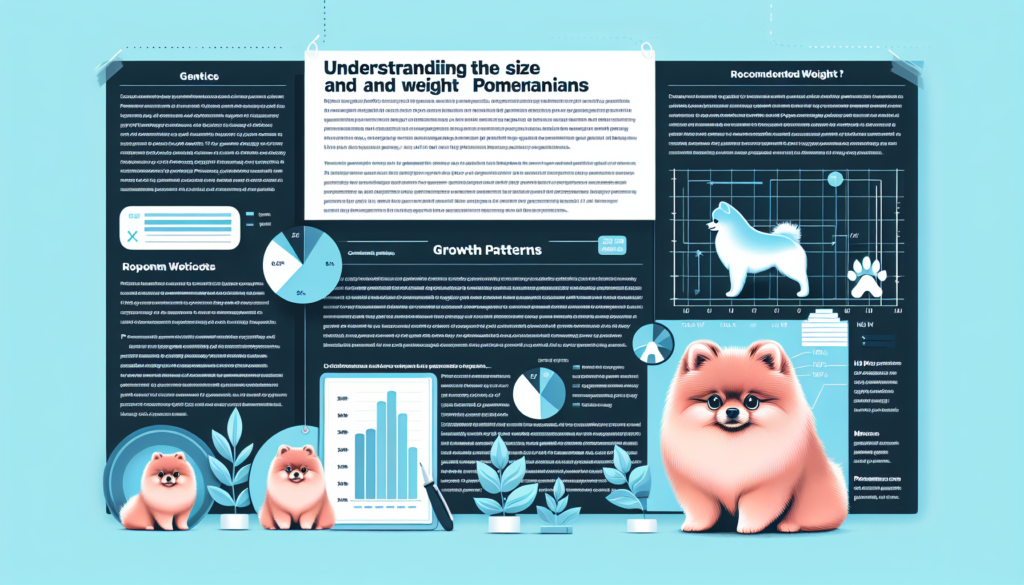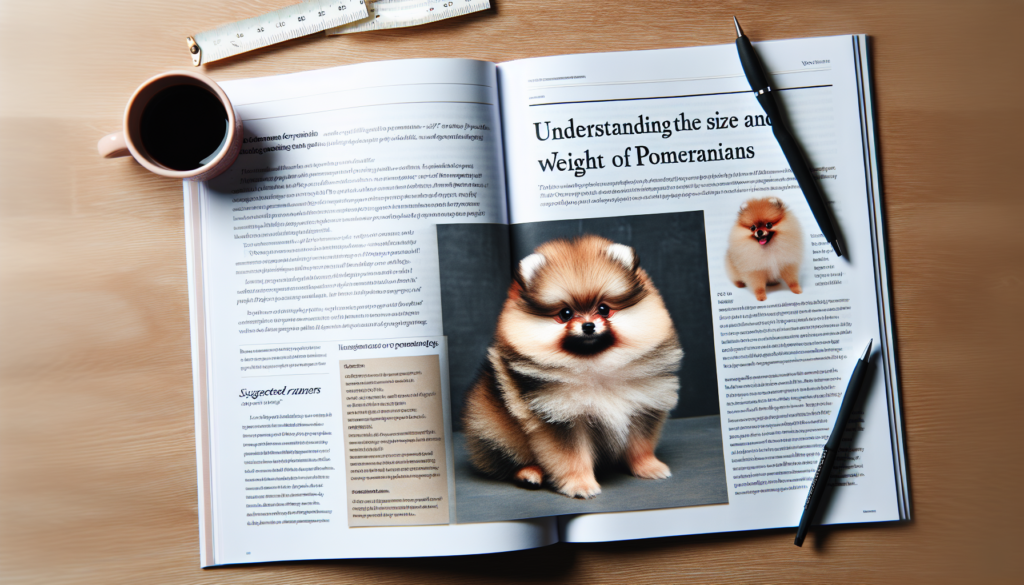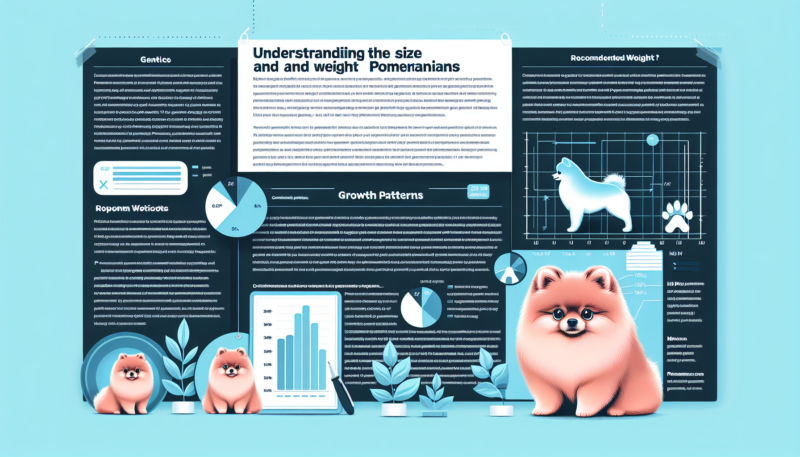If you’ve ever wondered just how small and adorable Pomeranians can be, then this article is for you! Get ready to be charmed by these tiny furballs as we explore the size and weight of Pomeranians. From their petite frames to their fluffy coats, we’ll take a closer look at what makes these delightful dogs so unique. So, whether you’re a Pomeranian owner or simply a dog lover, sit back, relax, and prepare to be amazed by the cuteness overload that is the Pomeranian breed.
Understanding the Size and Weight of Pomeranians
Pomeranians are small and fluffy dogs that have gained immense popularity due to their adorable appearance and charming personality. If you are considering bringing a Pomeranian into your home, it is important to understand their size and weight characteristics to ensure you can provide them with the proper care they need. In this article, we will delve into the various aspects of Pomeranian size and weight, including factors that affect their size, growth stages, differences between males and females, the role of nutrition and exercise, and health issues related to size.

Overview of the Pomeranian Breed
Originating from the larger sled-pulling Spitz dogs of the Arctic region, Pomeranians have come a long way to become the toy-sized companions we know today. These delightful dogs are known for their fluffy double coats, fox-like faces, and lively personalities. Pomeranians are part of the toy group of dog breeds, meaning they are small in size and weigh significantly less compared to larger breeds like Great Danes. Despite their diminutive stature, they have a big personality that makes them a joy to be around.
Average Size of a Pomeranian
Pomeranians typically stand between 6 to 7 inches tall at the shoulder, measured from the highest point of their shoulder blades. When it comes to length, a Pomeranian can vary from around 8 to 11 inches, depending on the individual dog. These measurements provide a general idea of the size of a Pomeranian, but it is important to note that there is some variation within the breed.
In terms of weight, Pomeranians typically range from 3 to 7 pounds. However, some Pomeranians may weigh slightly more or less depending on factors such as genetics, age, and overall health.
Factors Affecting Pomeranian Size
A variety of factors can influence the size of a Pomeranian. One significant factor is genetics and breeding. Just like with humans, genes play a role in determining the size and structure of a Pomeranian. If a Pomeranian’s parents are smaller in size, it is more likely that the offspring will be smaller as well.
Age and growth stage also play a role in determining a Pomeranian’s size. Pomeranians go through various growth stages, from the neonatal stage to the adult stage. During these stages, their bodies grow and develop, which can affect their overall size.
Health and nutrition are other crucial factors. A Pomeranian’s overall health, as well as the quality and quantity of their diet, can influence their growth and size. Optimal nutrition is essential for proper growth and development.
Environmental factors can also impact a Pomeranian’s size. The environment in which a Pomeranian grows up can affect their physical development.
Understanding Weight Variations
Within the Pomeranian breed, weight variations can occur due to factors such as variations in genetics and breeding, age, and general health. Additionally, Pomeranians can be classified into two groups: toy group and standard group. Toy Pomeranians tend to be at the lower end of the weight range, while standard Pomeranians may weigh slightly more but still fall within the average weight range for the breed.
The weight of a Pomeranian can also vary between puppies and adults. Puppies are typically smaller and lighter compared to adult Pomeranians. As they grow and mature, they gain weight and reach their full adult size.
It is important to note that maintaining a healthy weight is essential for Pomeranians. Being overweight can lead to various health issues, so it is essential to monitor their weight and ensure they maintain a proper diet and exercise regime.

Pomeranian Growth Stages
Pomeranians go through several growth stages as they develop from puppies to adults. These stages are essential for their overall physical and mental development. Understanding these growth stages can help you better care for your Pomeranian and support their healthy growth.
-
The neonatal stage occurs from birth to around 2 weeks old. During this stage, Pomeranian puppies are entirely dependent on their mother for nourishment and warmth.
-
The transitional stage lasts from 2 to 4 weeks old. Puppies begin to open their eyes and ears, and they start to become more active and explore their surroundings.
-
The socialization stage takes place from 4 to 12 weeks old. This is a critical period for puppies to learn and interact with their littermates and humans. Socialization during this stage sets the foundation for their future behavior and temperament.
-
The juvenile stage occurs from 3 to 6 months old. Puppies start losing their baby teeth and grow their adult teeth during this stage.
-
The adolescent stage spans from 6 to 12 months old. Pomeranians reach their sexual maturity during this stage, and their growth slows down compared to the previous stages.
-
The adult stage begins around 12 months old, although Pomeranians may continue to fill out and develop until around 18 months old. At this stage, they have reached their full physical maturity.
Size Differences between Males and Females
Male and female Pomeranians may have slight size differences due to sexual dimorphism. On average, male Pomeranians tend to be slightly larger compared to females. However, it is important to remember that individual variation exists within the breed, and the sizes may overlap between males and females.
On average, male Pomeranians may have a height at the shoulder ranging from 7 to 12 inches, while females may measure around 6 to 11 inches. When it comes to weight, males typically weigh between 4 to 7 pounds, while females weigh around 3 to 6 pounds. These ranges provide a rough estimate, and it is important to consider factors such as genetics and breeding when assessing the size of an individual Pomeranian.
The Importance of Proper Nutrition
Proper nutrition is vital for the healthy development of Pomeranians. A well-balanced diet ensures they receive the necessary nutrients for growth, muscle development, and overall health. It is essential to provide them with high-quality dog food that is specifically formulated for their size and age.
When choosing the right dog food for your Pomeranian, look for options that contain high-quality protein sources, such as chicken or fish. Pomeranians also benefit from foods that are rich in healthy fats for their coat and skin health. Additionally, ensure that their diet includes a variety of fruits and vegetables to provide essential vitamins and minerals.
Portion control is another crucial aspect of feeding Pomeranians. Overfeeding can lead to excessive weight gain, which may result in health issues. It is important to follow proper portion sizes recommended by your veterinarian.
Supplements can also be beneficial for optimal growth. Omega-3 fatty acids, for example, can promote healthy skin and coat, while joint supplements can support their bone and joint health. However, it is important to consult with your veterinarian before introducing any supplements to your Pomeranian’s diet.
Exercise and its Impact on Size
regular exercise is essential for Pomeranians to maintain a healthy weight, muscle tone, and overall well-being. While Pomeranians are a small breed, they still require daily exercise to keep them physically and mentally stimulated.
The role of exercise in Pomeranian development varies depending on their age. Puppies have plenty of energy and should engage in appropriate play and exercise activities to develop coordination and strength. Adult Pomeranians also benefit from daily exercise to prevent obesity and maintain a healthy weight.
It is important to strike a balance between exercise and rest. Pomeranians should have structured exercise sessions throughout the day but also have ample time to rest and recover. Avoid overexercising puppies or pushing them beyond their limits, as excessive exercise can cause stress on their developing joints and bones.
Health Issues Related to Size
Size can contribute to certain health issues in Pomeranians. Small dog breeds like Pomeranians can be more prone to dental problems, such as tooth decay and periodontal disease. Regular dental care, including brushing their teeth and providing appropriate chew toys, can help prevent dental issues.
Patellar luxation, a condition where the kneecap dislocates, is another health issue that can affect Pomeranians. Maintaining a healthy weight and avoiding excessive jumping or strenuous activities can help reduce the risk of patellar luxation.
Tracheal collapse is more common in toy-sized breeds like Pomeranians. The collapse of the trachea, the windpipe, can cause coughing, difficulty breathing, and other respiratory issues. Avoid using collars that put pressure on the neck and instead use a harness to prevent unnecessary strain on the trachea.
Tips for Managing the Size and Weight of Pomeranians
To ensure that your Pomeranian maintains a healthy size and weight, here are some essential tips to keep in mind:
-
Regular Veterinary Check-ups: Regular visits to the veterinarian will help monitor your Pomeranian’s growth and overall health. Your vet can also provide guidance on proper diet, exercise, and any specific concerns related to your Pomeranian’s size.
-
Maintaining a Healthy Diet: Providing a balanced diet that meets your Pomeranian’s nutritional needs is essential. Consult with your veterinarian to determine the appropriate portion sizes and feeding frequency for your dog.
-
Exercise and Playtime: Engage your Pomeranian in regular exercise and playtime to ensure they stay active and healthy. Daily walks, interactive toys, and mental stimulation activities are all great ways to keep them engaged.
-
Weight Monitoring: Keep an eye on your Pomeranian’s weight to ensure they are within the healthy range for their breed. If you notice any significant weight fluctuations, consult with your veterinarian for guidance.
-
Proper Grooming Techniques: Regular grooming, including brushing their coat and maintaining good dental care, is essential for the overall health and well-being of your Pomeranian.
In conclusion, understanding the size and weight of Pomeranians is crucial for providing them with appropriate care throughout their lives. By considering factors like genetics, nutrition, exercise, and health, you can support the healthy growth and development of your Pomeranian companion. With proper care, your Pomeranian will thrive and bring joy to your life for many years to come.
